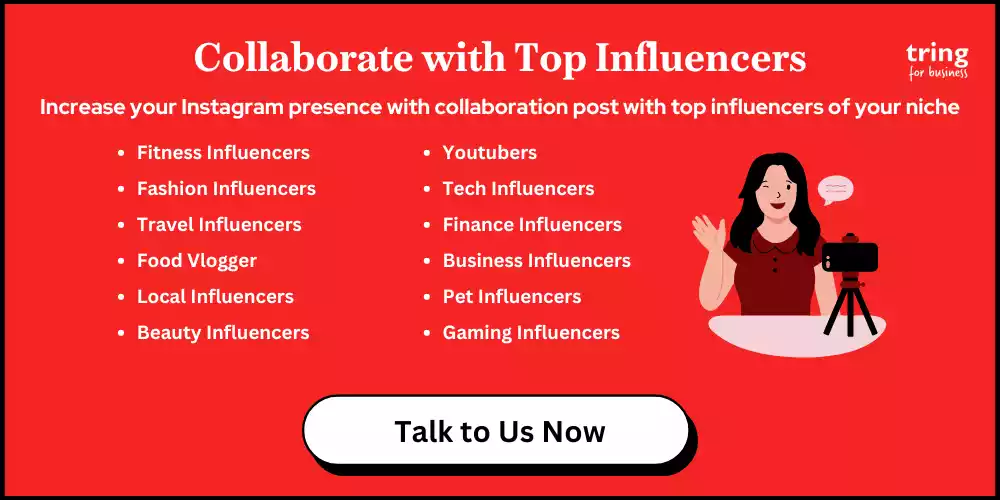![How To Create A Successful Influencer Marketing Campaign How To Create A Successful Influencer Marketing Campaign]()
What is Influencer Marketing Campaign?
An influencer marketing campaign involves partnering with individuals who have a large and engaged following on social media platforms to promote a brand's products or services. These influencers create content that resonates with their audience, endorsing the brand in a way that feels authentic and relatable. The campaign's goal is to leverage the influencer's trust and reach to increase brand awareness, drive consumer engagement, and ultimately boost sales. It's a modern, effective strategy that combines social media power with organic promotion to connect brands with their target customers.
Top 5 Influencer Marketing Campaigns in India
Influencer marketing has gained massive momentum in India, with brands leveraging the power of social media personalities to reach their target audience. These campaigns have been instrumental in connecting brands with younger, tech-savvy consumers. Here are five notable examples of successful influencer marketing campaigns in India:
1. Vivo's Z1Pro with Tech Influencers
Vivo, a smartphone brand, partnered with prominent tech influencers such as Technical Guruji and Geeky Ranjit for the launch of its Vivo Z1Pro. These influencers created detailed reviews, unboxing videos, and first-impression content, targeting gadget enthusiasts and millennials. Their campaigns made a direct impact on Vivo's sales as consumers trust these tech experts’ opinions. The buzz created by these influencers gave Vivo a huge boost in its competitive market.
2. Realme’s Collaboration with YouTube Stars
Realme, another mobile brand, frequently partners with content creators like Bhuvan Bam and Ashish Chanchlani. These popular YouTubers used their humorous, relatable content to promote Realme's smartphones, making the product accessible to younger audiences. By embedding the product in their natural comedic content, these influencers generated immense engagement for Realme, proving that influencer marketing campaigns can effectively blend entertainment with product promotion.
3. Daniel Wellington and Fashion Influencers
Daniel Wellington, a luxury watch brand, utilized influencer marketing by partnering with fashion influencers such as Komal Pandey and Kusha Kapila. These collaborations featured styled photoshoots and videos where influencers showcased the watches in daily life, seamlessly blending fashion and lifestyle content with product placement. By focusing on aspirational, relatable influencers, Daniel Wellington’s campaign helped increase its popularity among the fashion-conscious youth in India.
4. Nykaa’s Collaboration with Beauty Influencers
Nykaa, a leading beauty e-commerce platform, frequently collaborates with beauty bloggers and makeup artists like Malvika Sitlani and Shreya Jain. These influencers share tutorials and product recommendations that engage a large community of beauty enthusiasts. Nykaa’s strategy effectively drove traffic to their platform and encouraged product sales.
5. Mamaearth's Campaign with Kiara Advani and Shilpa Shetty
Mamaearth, a skincare and wellness brand, has collaborated with Bollywood celebrities like Kiara Advani and Shilpa Shetty. Their campaigns focus on natural beauty products that align with eco-conscious consumers. Mamaearth leveraged these influencers’ social media presence to promote its toxin-free products, resulting in a significant spike in brand recognition and customer engagement. The collaboration with Kiara Advani, in particular, generated buzz around the brand's focus on purity and sustainability.
These campaigns highlight how Indian brands across diverse sectors—skincare, technology, fashion, and oral care—are creatively leveraging influencer marketing to connect with their audience.The versatility of influencer marketing proves it to be a winning strategy in India's digital landscape.
Get an Influencer to Promote Your Brand Now!
![Collaborate with Influencers.png Collaborate with Influencers]()
How Will You Define Your Influencer Marketing Campaign Goals?
Defining your influencer marketing campaign goals is essential to creating a successful strategy. These goals will guide your campaign’s direction and help you measure success. Here are some key steps to help you define your influencer marketing campaign goals:
1. Identify Your Primary Objectives
Start by determining what you want to achieve. Are you focused on increasing brand awareness, driving sales, boosting social media engagement, or launching a new product? Your objective shapes your approach. For instance, if you’re launching a product, your goal could be building excitement and creating visibility around the launch.
2. Understand Your Audience
Align your campaign goals with the needs and preferences of your target audience. Knowing who your audience is will help you tailor your campaign message and influencer selection. Are they younger, tech-savvy consumers? Or is your target group more family-oriented? Knowing your audience helps you choose the right influencers who can connect with your potential customers.
3. Set Specific, Measurable KPIs
Define Key Performance Indicators (KPIs) that will measure success. These should be specific, measurable, attainable, relevant, and time-bound (SMART). For example:
-
Awareness: Track metrics like reach, impressions, and follower growth.
-
Engagement: Measure likes, comments, shares, and social media mentions.
-
Sales: Use tracking links or discount codes to monitor conversions.
4. Budget Allocation
Determine how much you’re willing to invest in your influencer marketing campaign. Different influencers come with varying costs depending on their following, engagement rate, and niche. Establish a budget early, so you can prioritize influencers who fit within your financial limits and goals.
5. Ensure Brand Alignment
Your goals should reflect your brand’s core values and identity. When defining your campaign goals, ensure that the influencers you work with align with your brand message. This ensures authenticity and fosters trust with your audience.
6. Timeframe for Achievement
Set a realistic timeframe for your campaign goals. Some goals may take longer to achieve, especially if they involve brand awareness or long-term partnerships with influencers. Make sure your goals are adaptable within the timeframe you set to monitor progress and adjust strategies if needed.
Clearly defined influencer marketing campaign goals provide a roadmap for success and a benchmark to evaluate the campaign’s effectiveness.
How to Create a Successful Influencer Marketing Campaign?
Creating a successful influencer marketing campaign involves careful planning, strategy, and execution. We’ve shared the best influencer marketing campaign ideas that you can use to grow your brand/ business. ![How to Create a Successful Influencer Marketing Campaign? How to Create a Successful Influencer Marketing Campaign?]()
Here’s a step-by-step guide to ensure your campaign drives results and meets your business objectives:
1. Define Your Goals and Objectives
The first step is to define what you want to achieve through your campaign. Common goals include:
-
Brand Awareness: Expanding your reach and visibility.
-
Engagement: Increasing likes, comments, shares, and overall interaction.
-
Conversions: Driving sales or leads from influencer content. Once you’ve identified your goals, align your campaign structure and metrics to measure success.
2. Understand Your Target Audience
Your campaign should speak directly to your target audience. Understand their demographics, preferences, and pain points. This ensures that the influencers you choose are trusted by and relatable to your audience. Whether they are young, urban millennials or middle-aged professionals, identifying who they are will shape your influencer choice and content.
3. Choose the Right Influencers
Selecting influencers whose values align with your brand is critical. They should genuinely resonate with your target audience. Influencers are typically categorized into:
-
Mega Influencers: Celebrities with millions of followers, often chosen for large-scale awareness campaigns.
-
Macro Influencers: Well-known personalities in specific industries with a large follower base (100k–1M).
-
Micro Influencers: Individuals with niche audiences (10k–100k), often seen as more relatable and trusted.
-
Nano Influencers: Individuals with smaller, highly engaged communities (1k–10k).
Ensure that the influencer you select matches your campaign goals. A beauty influencer for a skincare product would make sense, but a tech influencer wouldn’t be appropriate for the same brand.
4. Set a Budget
Campaign costs can vary depending on influencer size, engagement rate, and deliverables. Micro and nano influencers may be cost-effective, while mega influencers can be significantly more expensive. Besides influencer fees, also account for production costs, platform ad spends, and any giveaways or collaborations.
5. Craft a Clear Message and Brief
Provide influencers with a detailed brief outlining your brand’s messaging, goals, and expectations. However, allow them the creative freedom to connect with their audience authentically. A rigid script can come off as disingenuous. The brief should include:
-
Key messaging points.
-
Content guidelines (visual, tone, etc.).
-
Posting schedule and deadlines.
-
Platform-specific instructions (e.g., Instagram posts, YouTube videos).
6. Leverage Multiple Platforms
Choosing the right platform for your campaign is crucial. Some brands focus solely on Instagram, while others may find more value in YouTube or Instagram. Combining platforms like Instagram (for visuals), YouTube (for in-depth content), and Twitter (for conversations) can maximize impact.
7. Monitor and Track Performance
Tracking the performance of your influencer marketing campaign is essential to gauge success. Utilize tools such as UTM links, affiliate codes, or unique discount coupons to measure engagement and conversions. KPIs like reach, impressions, engagement rate, click-through rates, and ROI help you understand what’s working and what isn’t.
8. Engage with Influencer Content
To amplify your campaign’s success, actively engage with the content influencers post on your behalf. Share the posts, comment, and respond to audience questions. This shows that your brand is active and values community feedback.
9. Ensure Compliance
Influencer marketing is regulated, and it’s important to comply with legal standards, including transparent labeling of paid or sponsored content. In many countries, failing to disclose paid partnerships can result in penalties. Be sure influencers tag their content appropriately (e.g., using #ad or #sponsored).
10. Evaluate the Campaign
Post-campaign, take time to analyze the overall performance and compare it with your initial goals. Did you achieve the desired reach or sales? What were the audience's reactions? Use these insights to refine your future influencer marketing campaigns.
A successful influencer marketing campaign requires a clear strategy, influencer selection aligned with your brand’s values, and continuous monitoring.
Collaborate With an Influencer to Promote Your Brand!
![Collaborate with Top Influencers.png]()
Things to Write in an Influencer Marketing Campaign Brief
An influencer marketing campaign brief is a crucial document that outlines the objectives, expectations, and guidelines for a successful collaboration between brands and influencers. Crafting a comprehensive and clear brief ensures that both parties are aligned and can maximize the effectiveness of the campaign. Here are essential elements to include in your influencer marketing campaign brief.
1. Campaign Objectives
Begin your brief by clearly defining the goals of the campaign. Are you aiming to increase brand awareness, drive sales, launch a new product, or enhance social media engagement? Be specific and measurable, using key performance indicators (KPIs) to track success. For instance, if your objective is to boost sales, specify a target percentage increase or a dollar amount.
2. Target Audience
Detail the demographics of your target audience, including age, gender, location, interests, and purchasing behavior. This information helps influencers tailor their content to resonate with their followers. Providing insights into your audience’s preferences will enable influencers to craft messages that align with what their followers care about, increasing the chances of engagement and conversion.
3. Brand Guidelines
Include clear brand guidelines to ensure that influencers understand your brand’s voice, tone, and aesthetic. This section should cover aspects such as preferred language, visual style, color schemes, and any do’s and don’ts related to brand representation. Consistency in branding is vital, as it helps maintain a cohesive image across all platforms.
4. Content Requirements
Outline the specific types of content you expect from the influencer. Will it be photos, videos, blog posts, or social media stories? Specify the number of posts, format, and any essential messaging that must be included. Additionally, mention any hashtags, links, or mentions that should be incorporated to enhance tracking and brand visibility.
5. Timeline and Deadlines
Clearly state the timeline for the campaign, including key deadlines for content submission, approval, and posting. This ensures that both parties are on the same page regarding schedules and can help avoid last-minute rushes. Consider including a timeline for any pre-launch teasers or promotional activities leading up to the main campaign launch.
6. Compensation and Deliverables
Detail the compensation structure for the influencer’s participation, whether it’s a flat fee, commission-based, or product exchange. Be transparent about what the influencer will receive and any additional perks, such as exclusive access or experiences. Also, specify the deliverables, including the number of posts and platforms where the content will be shared.
7. Performance Metrics
Discuss how the campaign’s success will be measured. Include specific metrics such as engagement rates, reach, impressions, website traffic, or sales conversions. Establishing clear performance metrics allows both the brand and influencer to assess the effectiveness of the campaign and make necessary adjustments in real time.
8. Legal and Disclosure Guidelines
Inform influencers about any legal requirements related to advertising and endorsements. This includes guidelines on disclosing paid partnerships, using hashtags like #ad or #sponsored, and adhering to relevant advertising regulations. Ensuring compliance not only maintains transparency with audiences but also protects both the brand and influencer from potential legal issues.
A well-crafted influencer marketing campaign brief is essential for ensuring a successful collaboration between brands and influencers. This alignment can lead to creative and impactful campaigns that resonate with audiences and achieve your marketing goals.
10 Quick Tips for Creating an Influencer Marketing Campaign Template
![Quick Tips for Creating an Influencer Marketing Campaign Template Quick Tips for Creating an Influencer Marketing Campaign Template]()
-
Outline Specific Campaign Goals
Write down precise goals such as "Increase website traffic by 30% in one month" or "Achieve 1,000 new followers on Instagram."
-
Select Influencer Criteria
Create a checklist of must-haves for influencers, such as "Minimum 50,000 followers," "Engagement rate above 3%," and "Experience in the health and wellness niche."
-
Draft a Shortlist of Potential Influencers
Use tools like BuzzSumo or Upfluence to compile a list of 10-15 influencers who meet your criteria. Include their contact info and engagement metrics.
-
Define Content Types and Formats
Specify content formats (e.g., "3 Instagram posts, 2 stories, and 1 YouTube video") and any required features, like "Include a demo of the product in use."
-
Set a Realistic Budget Breakdown
Create a budget table that allocates funds for influencer fees, content production, and paid promotions. For example, “Influencer Fee: $1,000; Content Production: $300.”
-
Establish a Clear Approval Process
Outline the steps for content approval, including who reviews the content and the turnaround time (e.g., "Content must be submitted 7 days before posting for review").
-
Create a Detailed Posting Schedule
Develop a calendar that specifies exact posting dates and times for each content piece, ensuring a coordinated rollout.
-
Specify Key Performance Indicators (KPIs)
List the metrics you’ll use to evaluate success, such as "Track link clicks via UTM parameters" or "Monitor hashtag performance with Sprout Social."
-
Include Guidelines for Authenticity
Provide specific instructions on how influencers should integrate your brand into their content (e.g., "Share a personal story related to the product").
-
Plan for Post-Campaign Analysis
Schedule a review meeting after the campaign to assess performance against your KPIs and gather insights for future campaigns. Create a checklist for what data to collect, such as engagement rates and sales figures.
By following these actionable tips, you can create a focused and effective influencer marketing campaign template that drives results.
Tips to Tracking Influencer Marketing Campaign’s Success
Tracking the success of your influencer marketing campaign is crucial to understanding its impact and refining future strategies. Here are some tips to effectively monitor and measure the outcomes of your campaign:
1. Define Clear KPIs
Before launching your campaign, establish key performance indicators (KPIs) aligned with your campaign goals. Common KPIs include reach, engagement rates (likes, comments, shares), click-through rates, and conversion rates. By clearly defining what success looks like, you can more effectively measure results.
2. Use Tracking Links
Implementing unique tracking links for each influencer can provide valuable data on traffic and conversions generated from their content. Tools like Bitly or Google Analytics allow you to see how many people clicked on the link and what actions they took afterward. This information is essential for assessing the direct impact of each influencer on your sales or leads.
3. Monitor Social Media Metrics
Leverage social media analytics tools to track engagement metrics, such as likes, comments, shares, and follower growth. Most social media platforms offer built-in analytics tools that provide insights into audience interactions. Analyzing these metrics helps you understand which content resonates most with your audience.
4. Engagement Rate Calculation
Instead of solely focusing on follower counts, calculate the engagement rate by dividing the total engagement (likes, comments, shares) by the number of followers. This gives you a clearer picture of how effectively the influencer's audience interacts with their content. High engagement rates often indicate that the influencer has a loyal and active following.
5. Collect Qualitative Feedback
In addition to quantitative metrics, gather qualitative feedback from your audience. Monitor comments and discussions about your brand or campaign on social media. This helps you understand the sentiment surrounding your campaign and identify areas for improvement.
6. Analyze Content Performance
Evaluate which types of content performed best during the campaign. Did videos get more engagement than static posts? Are certain topics more appealing? This analysis allows you to refine your content strategy for future campaigns based on what worked well.
7. Set Up A/B Testing
Conduct A/B testing by collaborating with multiple influencers and varying the messaging, visuals, or formats. By comparing results from different approaches, you can identify what resonates best with your audience and optimize future campaigns accordingly.
8. Measure Brand Sentiment
Use social listening tools to track mentions of your brand across social media platforms. Analyzing brand sentiment helps you gauge how your audience feels about your brand before, during, and after the campaign, providing insights into its overall impact.
9. Assess ROI
Finally, calculate the return on investment (ROI) of your influencer marketing campaign. This involves comparing the costs of working with influencers to the revenue generated as a result. A positive ROI indicates a successful campaign, while a negative ROI highlights areas needing adjustment.
By following these tips, you can effectively track the success of your influencer marketing campaign, ensuring that you gather valuable insights to inform future strategies. Continuous measurement and analysis are key to evolving your campaigns and maximizing their effectiveness in reaching your marketing goals.
Do You Want to Collaborate With an Influencer to Promote Your Brand?
Ready to take your brand to the next level?
Collaborating with an influencer can significantly boost your visibility and engagement. Whether you’re looking to create authentic content or reach new audiences, our team can connect you with the perfect influencer for your brand. Don’t miss out on the opportunity to elevate your marketing strategy.
Contact us today to explore potential collaborations and watch your brand thrive!
![button_talk-to-us.png]()
![birthday occasion]() Birthday Gifts
Birthday Gifts
![anniversary occasion]() Anniversary Gifts
Anniversary Gifts
![women]() Women
Women
![men]() Men
Men
![Couples]() Couples
Couples
![Couples]() Wedding Gifts
Wedding Gifts

 Birthday Gifts
Birthday Gifts
 Women
Women
 Men
Men
 Anniversary Gifts
Anniversary Gifts
 Wedding Gifts
Wedding Gifts






 We now support international payments
We now support international payments
